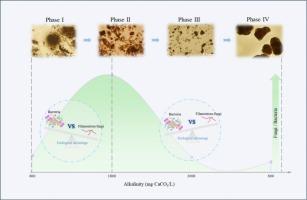碱度在分解嗜盐好氧颗粒污泥处理高盐碱废水的回收中的作用:真菌和细菌群落生态学的见解
IF 13.2
1区 工程技术
Q1 ENGINEERING, CHEMICAL
引用次数: 0
摘要
丝状真菌的过度生长是引起嗜盐好氧颗粒污泥(HAGS)解体的主要因素。然而,控制丝状真菌过度生长和维持真菌和细菌之间的生态位平衡在很大程度上仍然未知。本研究揭示了高盐碱废水处理过程中碱度对真菌和细菌群落生态的影响,提出了修复分解HAGS的策略。碱度的变化导致真菌和细菌群落生态的重塑。随着碱度从600 ~ 3000 mg CaCO3/L增加,真菌和细菌的种群多样性下降;菌科真菌丰富,细菌属TM7x的相对丰度逐渐增加。高碱度(3000 mg CaCO3/L)显著抑制丝状真菌的生长,细菌获得更大的底物竞争优势。随着碱度的增加,真菌对氨的去除率从51.22 %下降到39.73 %,而自养菌的去除率从28.76 %上升到42.31 %。当碱度恢复到600 mg CaCO3/L时,真菌种群数量的减少和细胞外聚合物质的分泌增加促进了致密颗粒的重建(平均粒径为762.9 ± 1.95 μm)。本研究发现碱度可以影响真菌和细菌的底物竞争优势,从而控制丝状真菌的过度生长。这一发现为控制真菌过度生长和恢复崩解HAGS的结构稳定性提供了坚实的理论基础。本文章由计算机程序翻译,如有差异,请以英文原文为准。

Alkalinity role in recovery of disintegrated halophilic aerobic granular sludge treating high salt-alkali wastewater: Insights into community ecology of fungi and bacteria
The overgrowth of filamentous fungi is a major factor causing the disintegration of halophilic aerobic granular sludge (HAGS). However, controlling filamentous fungal overgrowth and sustaining the niche balance between fungi and bacteria remain largely unknown. In this study, the influence of alkalinity on the fungal and bacterial community ecology was revealed when treating high salt-alkali wastewater, proposing a strategy to restore disintegrated HAGS. Changes in alkalinity resulted in remodeling the community ecology of fungi and bacteria. With alkalinity increasing from 600 to 3000 mg CaCO3/L, the population diversity of fungi and bacteria declined; fungi in the Nectriaceae family were enriched, and the relative abundance of bacterial genus TM7x gradually increased. The growth of filamentous fungi was significantly inhibited under high alkalinity (3000 mg CaCO3/L), and bacteria obtaining a greater substrate competitive advantage. The ammonia removal contribution of fungi decreased from 51.22 % to 39.73 % with increasing alkalinity, while the contribution of autotrophic bacteria increased from 28.76 % to 42.31 %. When the alkalinity was restored to 600 mg CaCO3/L, the decrease in the fungal population size and the increase in the secretion of extracellular polymeric substances promoted the reconstructed of dense granules (mean size 762.9 ± 1.95 μm). This study found that alkalinity could make influences on the substrate competitive advantage of fungi and bacteria, and thus filamentous fungal overgrowth can be controlled. This finding provided a solid theoretical basis for controlling fungal overgrowth and restoring the structural stability of disintegrated HAGS.
求助全文
通过发布文献求助,成功后即可免费获取论文全文。
去求助
来源期刊

Chemical Engineering Journal
工程技术-工程:化工
CiteScore
21.70
自引率
9.30%
发文量
6781
审稿时长
2.4 months
期刊介绍:
The Chemical Engineering Journal is an international research journal that invites contributions of original and novel fundamental research. It aims to provide an international platform for presenting original fundamental research, interpretative reviews, and discussions on new developments in chemical engineering. The journal welcomes papers that describe novel theory and its practical application, as well as those that demonstrate the transfer of techniques from other disciplines. It also welcomes reports on carefully conducted experimental work that is soundly interpreted. The main focus of the journal is on original and rigorous research results that have broad significance. The Catalysis section within the Chemical Engineering Journal focuses specifically on Experimental and Theoretical studies in the fields of heterogeneous catalysis, molecular catalysis, and biocatalysis. These studies have industrial impact on various sectors such as chemicals, energy, materials, foods, healthcare, and environmental protection.
 求助内容:
求助内容: 应助结果提醒方式:
应助结果提醒方式:


